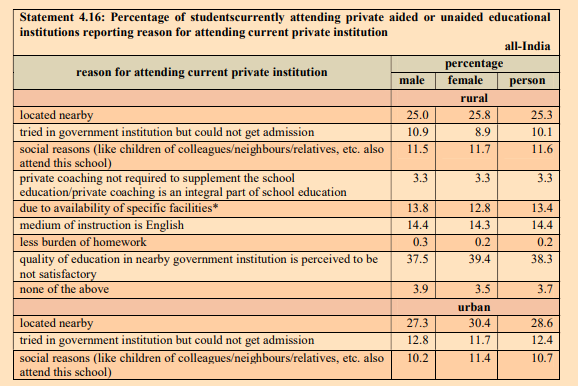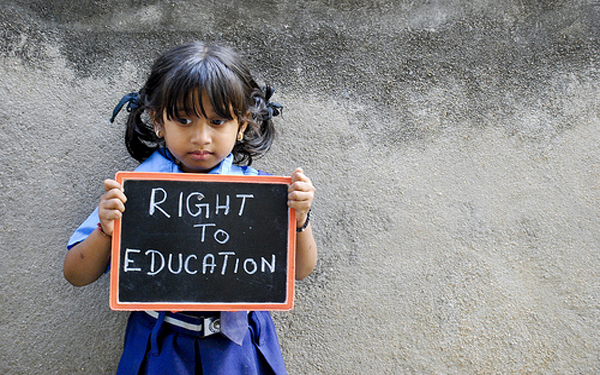The National Statistical Organization (NSO) recently presented its detailed findings from its nation-wide survey on household social consumption of education in India. The survey collected information on various aspects of education such as literacy levels, accessibility, cost of education, attendance, and so on.
The survey covers the whole of the Indian Union except the villages in the Andaman and Nicobar Islands which are difficult to access.
Literacy Rates
Overall, the NSO education survey found that the literacy rate in rural areas was 73.5% compared to 87.7% in urban areas. The female literacy rate was 70.3% while the male literacy rate was 84.7%. Kerala recorded the highest literacy rates amongst both men and women in rural and urban areas. Other states with high literacy rates were Uttarakhand and Himachal Pradesh.
The 90.8% literacy rate amongst men from general castes was much higher than the 77.5%, 80.3%, and 84.4% literacy rates amongst men from Scheduled Castes, Scheduled Tribes, and Other Backward Classes, respectively. While women from all castes had lower literacy rates, the 80.6% literacy amongst women from general castes was a contrast to the 61.3%, 63.9%, and 68.9% literacy rates amongst SC, ST, and OBC women respectively.
Out of the different religions, literacy rates were the lowest amongst both men and women who follow Islam, pointing to the exclusion of Muslims from the education system.
Access to Education
The time and cost of travelling to and from educational institutions can have a huge impact on the ability of students to continue attending classes.
According to the NSO education survey, while 92.7% of households in rural areas and 87.2% households in urban areas had a primary school within 1 km of their house, the percentage drops as one goes higher up in the education system. 68.1% of households in rural areas and 80.4% of households in urban areas had a school with primary/middle-level classes within a distance of 1 km. Only 37.5% of households in rural areas and 69.9% of households in urban areas had a school with secondary level classes within a distance of 1 km.
63.6% of students in rural areas, and 50% of students in urban areas travelled to school on foot.
Access to online education, as promoted by the NEP, is questionable as only 4.4% of rural households and 23.4% of urban households owned a computer of any kind. 14.9% of rural households and 42.0% of urban households had access to an internet facility. However, only 16.5% of male and female population above the age of 5 from rural and urban areas are able to operate a computer, and 20.1% are able to use the internet. Only 17.6% had used the internet in the last 30 days.
Enrollment Patterns and Drop Outs
Only 7.4 percent of the male rural population and 3.9 per cent of the female rural population had successfully completed education at a graduate level or above. In urban areas, the male population for the same was 24.6%, and the female population was 18.6%.
97.1% of male population and 98.3% of female population were pursuing general courses in rural areas, while the population for the same in urban areas was 91.7% and 93.7% for men and women respectively. Out of those who pursued technical/professional courses, the maximum students were pursuing engineering amongst both rural and urban men and women.
Enrollment in government educational institutions as compared to private institutions is higher at the primary level compared to higher education and in rural areas compared to urban education. As few as 13.9% of urban population is enrolled in government primary schools. The high enrollment in private institutions is mostly due to government schools’ quality of education not being perceived as satisfactory enough, as can be seen from the following table.

42.7% of rural and urban male students and 42.2% of rural and urban female students had enrolled at some point but are currently not attending educational institutions. The biggest reason for stopping their education amongst male students is engagement in economic activities and for female students it is engagement in domestic activities. All the other reasons can be seen in the table below.

Free and Affordable Education
The NSO education survey found that only 32.6 % of all students, rural and urban, are enrolled in primary education institutions where they receive free education. While the percentage is at 72.3% in rural areas, it is merely 14.2% in urban areas. 13.8% of all students, rural and urban, received any scholarship/stipend/reimbursement etc from any educational institution. 45.4% of all students, rural and urban, received free/subsidized textbooks from educational institutions. Only 9.2% of all students received free/subsidized stationery. Most of the students receiving free education, scholarships, free or subsidized textbooks, and free or subsidized stationery, belonged to government schools.
Only 41.8% of all students reported receiving midday meals from their educational institutions. Out of these 98.6% said that the government provided for these meals.
19.8% of all students had attended private coaching. The numbers were highest in the primary level, middle level, and higher secondary level in urban areas, being between 24% and 38%. In rural areas, the highest enrollment was at the secondary and higher secondary levels at 27.2 and 23.1% respectively. Such high percentage of enrollment in private coaching and tuition centres points to the low quality of education in schools.
While the measures set up in the public education system to increase access to education are a stark contrast to private education which leaves students to fend for themselves, the falling quality of education in government schools leads to those students who can afford it to choose private institutions, hence creating a disparity in the kind of education received by students.
Rather than promoting the privatisation of education, the government should be paying attention to improving the quality of government schools as the services provided by the public education system are crucial to the wellbeing of poor and marginalized children and students in the country.



